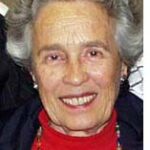By Eileen Wingard

LA JOLLA, California — Fascinating black and white film footage of New York City accompanied Gotham, by Michael Gordon, the opening work on the La Jolla Symphony and Chorus’ March 12 concert in Mandeville Hall at UCSD. Gordon, a Miami-born Jewish-American composer, has often teamed up with film-maker Bill Morrison to create multi-media works such as this one. Gotham is a nickname for New York City, originating from a Washington Irving short story, written in 1807, and that nickname has been further popularized by the Batman comic strip and movies.
The piece, in three movements, opens with a solo violin and piano accompanying a flock of sheep moving through Central Park. The seemingly rural vision enlarges into a cityscape, as more sections of the orchestra join in.
The second movement is characterized by an intense pulse in the orchestra and blaring glissandos in the trumpets. We see visions of crowded streets with people scurrying about.
The third movement begins with the violins in a wild jig as other instruments are added. The film shows construction workers on high skyscrapers and window washers. There is a repeated motif accompanying a rapid train from which we watch the tracks speedily spreading out ahead.
The vintage footage enhanced the music. Although the process may be reversed from that of film score writing, with footage selected to fit the music, rather than the music to fit the film, the end result is the same, with each medium contributing to the artistic whole. The music of Gotham is infused with elements of minimalism and popular culture, which seems a perfect match for the frenetic pace of life in NYC.
The composer, who trained in composition at Yale and played with rock bands in New York City, is the founder and artistic director, along with his wife, Julia Wolfe and David Lang, of New York’s Bang on a Can Festival. This is a festival in which the La Jolla Symphony’s conductor, Steven Schick, has frequently participated.
Following intermission, Schick led the orchestra, the La Jolla Chorus, prepared by David Chase, the North Coast Singers “Caprice” youth choir, prepared by their director, Sally Husch Dean, Mexico’s Lux Boreal Dance Company, tenor, John K. Russell and narrator, Alice Teyssler, in a performance of Igor Stravinsky’s Persephone.
San Diego seems to be experiencing a mini-Stravinsky festival this season, with the San Diego Symphony performing his Rite of Spring at their concerts the weekend of December 4, and his Firebird Suite the weekend of March 18, the visiting Montreal Symphony playing his Rite of Spring this March 23 and the La Jolla Symphony and Chorus with the addition of the aforementioned forces, performing his less frequently-heard, Persephone on March 12 and 13.
Persephone was commissioned by Ida Rubinstein, a Kharkov-born ballerina and actress from an orthodox Jewish family. Ida grew up in St. Petersburg and inherited a great deal of wealth from her father, who made his fortune from sugar mills, breweries and banks. The Rubinsteins were generous philanthropists, especially to the arts, and Ida followed suit, commissioning works by composers and choreographers such as Debussy, Ravel (she was the first to dance his Bolero) and Stravinsky. After leaving the Ballet Russe, she formed her own ballet company, which premiered Persephone. The work is based on a poem by Andre Gide, using the Greek myth about Demeter’s daughter, Persephone, who brings spring onto the land. Ida, too old to dance at the time, served as the narrator in the first performance.
Although the four pages of English translation of Gide’s text were dutifully included in the La Jolla Symphony’s printed programs, reading the text beforehand, one could hardly remember all the details. It was reminiscent of the days before super texts were used for operas, when one needed to read the librettos before hand to fully understand what was taking place on stage. Even then, we still could not understand the dialogue. If only there had been super texts for this excellent performance of Persephone.
However, there was much to admire in the performance. This music was from Stravinsky’s neo-classic period and was less dissonant and more tonal, at least in the section before Persephone’s abduction. The three dancers representing the nymphs, clad in gossamer white, pirouetted with ethereal grace, and the shades in hell, in black, modern-goth-like costumes, embodied the agony and darkness of the underworld. They demonstrated the versatility of the Lux Boreal dancers, encompassing movements from classical ballet as well as modern dance in the Martha Graham tradition.
The narrator, speaking in French, alternated positions on the stage from the rear to the sides, and, for the final section, changed from her earlier white dress to a black dress. There was a cord tied to the dancer representing Persephone, which was held by the shades in ell and the Nymphs on earth as they each tried to pull her. The three sections, Persephone Abducted, Persephone in the Underworld, and Persephone Restored, were well-delineated by the music. And the young voices of the Youth Choir, in the final section, sounded like a breath of fresh spring air.
Eumolpus, sung beautifully by tenor John K. Russell, actually told the story, while Alice Teyssier, the narrator, recited the words of Persephone.
Once again, the La Jolla Symphony and Chorus has brought us a program of seldom-heard music, well- executed.
*
Wingard is a freelance writer and retired violinist with the San Diego Symphony. She may be contacted via eileen.wingard@sdjewishworld.com. Comments intended for publication in the space below must be accompanied by the letter writer’s first and last name and his/her city and state of residence.